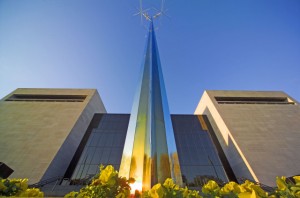Of Science and Cathedral-Building

The Daily Planet, my new companion blog here at Air & Space magazine, highlights a speech recently given by my good friend Dr. Neil Tyson at the Space Foundation breakfast. Noted is Neil’s oft-mentioned concept that historically, three drivers are responsible for societies or nations undertaking great collective endeavors, such as pyramid- or cathedral-building, New World exploration, or Apollo Moon programs. These drivers are waging war, seeking wealth, and the praise or worship of a deity. Neil believes that the first two are still operative in today’s world, but the last one is a quaint relic of some bygone era.
I feel the need to reconsider this elimination of the third driver. On many very fundamental levels, humanity never really changes. However, our terminology changes over time and I think that all three rationales are as valid today as ever. For the last category, we still construct monuments, have an elite priesthood to preside over it, and constantly revise and extend the current dogma. But we call it “science.”
I can already hear howls of protest from my scientific colleagues, but let’s step back a minute and examine the role and nature of science in today’s society. Science is commonly portrayed as the objective search for truth, as opposed to the superstitious or faith-based (depending upon which side of the fence you are) approach of religion. But science is not really as objective and pure as it is often portrayed and probably never was.
Modern science is a collective, social experience and as such, is subject to human failures and imperfections as is any societal institution. Moreover, science is most often funded by government, adding a layer of political accountability to what should be the objective search for truth. Most problems that we study in modern science are driven by social pressures and direction. Important problems are defined as those that the scientific community thinks are important. Often, these problems are deemed politically important and Congress will vote significant sums of money for their study.
Science deals with verifiable facts and observations. Scientists invent hypotheses to explain phenomena; the media often confuse the concept of hypothesis with that of theory, but in science, we have lots of hypotheses (which are a dime a dozen) but very few theories (which are well established edifices of knowledge, verified and confirmed by observation and experiment over a long period of time.) Scientific concepts and ideas should be subjected to vigorous question and debate.
But in fact, no modern scientist can investigate all phenomena to verify the results of others; we rely on peer review and the opinions of experts to evaluate the validity or lack thereof of new claims and discoveries. Thus, faith is an element of modern science too. The scientific establishment deals with heretics and mavericks, sometimes with amusing condescension and at other times with ostracization. Sometimes, particularly for scientific issues that have serious political or economic effects, the current paradigm becomes a catechism and woe to the scientist who dares to dissent from the “consensus” (which in science, sometimes merely reflects the absence of definitive evidence.) As in religion, we scientists also have our fundamentalists, ecumenicalists, and schismatics.
Science is indeed self-correcting in the long run, but the time constant of this corrective mechanism is sometimes longer than a given scientist’s career span. Thus, some scientists who were “right” never lived to see their vindication; Alfred Wegener, a German geologist who first articulated the evidence for continental drift early in the last century, was widely considered a crank during his lifetime. Only after the sea-floor had been mapped and sampled after World War II did we have the evidence that the continents had moved relative to each other.
Neil Tyson’s third motivator is still with us. We call it “Science” and it is a key driver for many social activities, including and especially for space exploration. The current focus of the Mars program is the Search for Life, a goal many scientists believe should be the motivator for the entire space program. Some pursue this idea with an intensity I can only describe as “religious” – it is there and we will find it!
Cathedral building is alive and well in the 21st century.
/https://tf-cmsv2-smithsonianmag-media.s3.amazonaws.com/accounts/headshot/blog_headshot_spudis-300x300.jpg)
/https://tf-cmsv2-smithsonianmag-media.s3.amazonaws.com/accounts/headshot/blog_headshot_spudis-300x300.jpg)